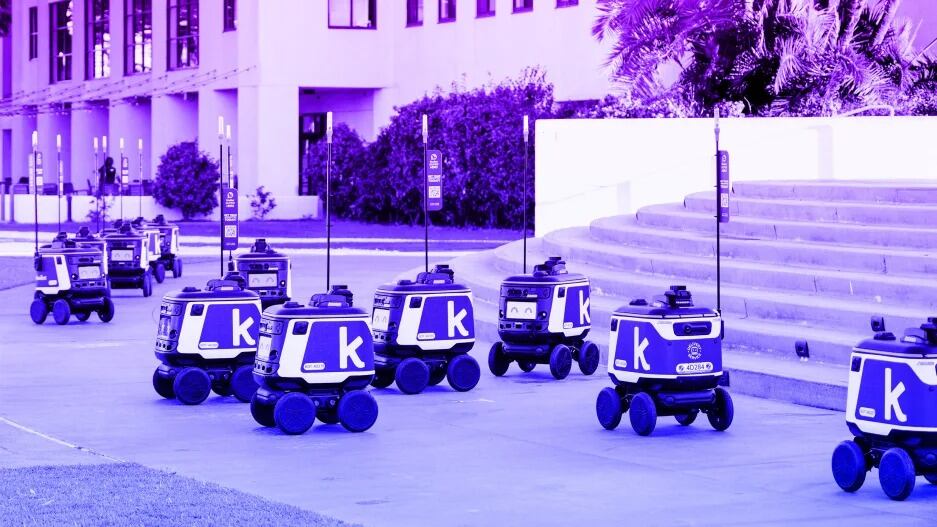- | 8:00 am
This is what cities need for widespread adoption of autonomous robots
The founder of Kiwibot says embracing robots as a public service is another step toward building the efficient cities of the future.

There are 3.5 million robots currently operating in factories—and they have started penetrating our daily activities too. Take Roombas, autonomous robotic vacuums, or Astros, home-monitoring robots. While these robots are solutions for homes and businesses, can implementing robots in public environments serve the needs of growing communities too?
To kick-start this idea, personal delivery devices (PDD) are already roaming around cities and college campuses to transport food, medicine, and groceries. The aim is for the robots to be carbon neutral to reduce greenhouse gas emissions from last-mile deliveries, which amount to 4 million tons annually in the U.S.
However, for this technology to thrive, cities must adapt their infrastructure and policies to regulate and maintain the safety of both citizens and robots. Likewise, public entities must launch education programs to help residents acclimatize to robots walking alongside them on sidewalks and delivering goods to their doorsteps.
Let’s explore how PDD operators and robotics companies can push for authorities to improve city infrastructure, prepare communities, and implement safety policies and regulations to welcome autonomous robots in public spaces.
IMPROVING INFRASTRUCTURE TO BUILD THE CITIES OF THE FUTURE
Up to one in four people in the U.S. have a disability, 11% of whom have reduced mobility. In response to this, 15-minute cities have emerged, ensuring every essential good is a stone’s throw away from residents’ doors. These people-centered cities wouldn’t be successful without efficient public infrastructure.
National Geographic has cataloged these cities of the future as well-built locations where people with disabilities have full access to every facility and service. Developers of smart cities, like Neom, agree. Their goals for people-centered municipalities include natural preservation, walkable spaces, and sustainable and smart architecture.
As full access to services is on the agenda, it’s time for city planners to add robots to the mix. They can help deliver food and necessities, clean up roads, and even patrol cities.
Cities can facilitate autonomous robots’ operations by building safer and more accessible public spaces, including sidewalks and crosswalks with clear signaling and stop signs.
Some organizations, like Open Mobility Foundation, have started implementing these improvements by creating an open-source governance structure—private and public entities share city traffic data for better mobility in urban areas.
Robotics companies can join these efforts by using their PDD data-gathering capabilities. The robots constantly collect infrastructure data, which could flag inefficiencies like inaccessible sidewalks for bots, and therefore people with reduced mobility. With this information, municipalities can quickly understand which areas need infrastructure improvements and ensure those with limited access are provided for.
IMPLEMENTING SAFETY POLICIES AND OPERATIONAL REGULATIONS
In 2021, Maryland became a beacon for PDD deployment in public areas by passing a law outlining operation regulations. It became mandatory for PDD operators to share their emergency response plans online for residents to access anytime, building trust and transparency with the community.
The hardest step is always starting, and it’s laws like Maryland’s that encouraged others to follow suit. Pittsburgh; Washington, D.C.; and the commonwealth of Virginia, among others, have since implemented them. Now robotics companies’ government relations and public policy departments can use these incoming laws to nudge other city authorities to jump on board.
Emerging regulations will make it easier for more robotics companies to offer their services for public use, helping the community with affordable deliveries. At the same time, governments can leverage the infrastructure feedback the robots capture. It’s a win-win situation.
GETTING COMMUNITIES INVOLVED WITH EDUCATION PROGRAMS
Residents might initially be reluctant to embrace new technologies, so it is essential to dispel myths and show how robots can meet people’s delivery needs sustainably. At the beginning of the education process, involving local authorities or nonprofits that work with communities can make a big difference in starting conversations with residents.
For example, the Knight Autonomous Vehicle Initiative is pioneering urban development via cutting-edge technology, and its approach to including communities is making the process easier. Its pilot project to deploy last-mile delivery robots across U.S. cities established a bridge between a robotic delivery company and residents to forge a trusted human-robot relationship from the beginning.
The bots yield the right-of-way to pedestrians, come in small sizes, walk at a human pace to avoid collisions, and display friendly expressions on their screens. So once people knew the ins and outs of the technology, it boosted their excitement and lowered their skepticism toward robots.
Companies must work with neighborhood leaders and community boards to understand the unique needs of local areas. This way, they can design informative tools, such as live demonstrations, social media alerts, and flyers, to reach their audience and educate them on the benefits of robotic operations.
Embracing robots as a public service is another step toward building the efficient cities of the future. Their zero-carbon footprint helps people meet their daily needs of collecting food and medicine in a more sustainable, efficient, and cost-effective way while increasing access to products for those with disabilities. PDD operators should take the initiative and encourage collaborations among governments, private companies, and residents to begin enhancing the human-robot relationship.







































